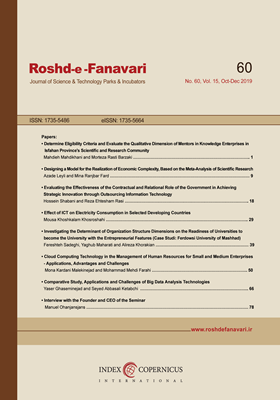Designing a Model for the Realization of Economic Complexity, Based on the Meta-Analysis of Scientific Research
Subject Areas :azadeh leili 1 , Mina Ranjbarfard 2
1 -
2 -
Abstract :
Implementing Business Intelligence Systems (BI) requires a lot of resources and time. The statistics show that billions of dollars are spent on these business intelligence systems (BIS), which show how important they are. Also, the cost of these systems is a large part of the expense of the organization. Unfortunately, with all these huge costs in these systems, more than half of the BI projects do not go to the real benefits of business intelligence systems. Here's one reason why organizations are not able to grasp the real benefits of business intelligence systems: Many of them are not ready for these systems. This is due to some of the challenges in implementing BI systems in organizations. BI implementation experiences show that the successful implementation of BI is beyond the implementation of technical infrastructure (hardware aspects) and requires the control of soft aspects and change management, which are recognized as the most difficult aspects of the successful implementation of BI applications. Business intelligence is a complex concept and has multi-layered architecture, which is why the BI readiness model is needed. Assessing BI readiness identifies specific implementation risk sections to manage and reduce these risks and thus increase the likelihood of BI success. So far, several models have been developed to prepare BI systems. In this paper, introduced models for BI readiness are presented, and then these models are compared based on the factors influencing BI readiness.
1- C. M. Olszak, E. Ziemba, “Approach to building and implementing business intelligence systems,” Interdisciplinary Journal of Information, Knowledge, and Management, vol. 2(1), pp. 135-148, 2007.
2- A. Nylund, “Tracing the BI family tree,” Knowledge Management, 60, 1999.
3- K. H. Ahmad, S. M. K. Quadri, "Business intelligence: an integrated approach," Business Intelligence Journal, vol. 5.1, pp.64-70, 2012.
4- S. Williams, N.Williams, "Business intelligence readiness: prerequisites for leveraging business intelligence to improve profits. The Profit Impact of Business Intelligence," pp.44-64, 2007.
5- Y. William, J. Gao, A. Koronios. "Towards a critical success factor framework for implementing business intelligence systems: A Delphi study in engineering asset management organizations," Research and Practical Issues of Enterprise Information Systems II. Springer, Boston, MA, pp.1353-1367, 2008.
6- S. Williams, N. Williams, “The profit impact of business intelligence,” Morgan Kaufmann, 2010.
7- C. Gärtner, "Enhancing readiness for change by enhancing mindfulness," Journal of Change Management, vol. 13.1 pp. 52-68, 2013.
8- W. Eckerson, “Smart companies in the 21st century: The secrets of creating successful business intelligence solutions,” TDWI The Data Ware housing Institute Report Series, pp.1-35, Retrieved, website: http://www.tdwi.org
9- W. Eckerson, “Performance dashboards: measuring, monitoring, and managing your business,” John Wiley & Sons, pp. 23-157, 2010.
10- A. H. Anjariny, A. M. Zeki, "Development of model for assessing organizations' readiness toward successful business intelligence systems," Research and Innovation in Information Systems (ICRIIS), 2011 International Conference on. IEEE, pp. 1-6, 2011.
11- A. Hejazi, N. Abdolvand, S. Rajaee Harandi. "Assessing The Organizational Readiness For Implementing BI Systems," International Journal of Information Technology Convergence and Services (IJITCS) vol.6, 2016.
12- A. H. Anjariny, A. M. Zeki, H. Hussin. "Assessing Organizations Readiness toward Business Intelligence Systems: A Proposed Hypothesized Model." Advanced Computer Science Applications and Technologies (ACSAT), International Conference on. IEEE, pp. 213-218, 2012.
13- T. Friedman, F. Buytendijk, F. Biscotti. "Readiness for BI: Toward the BI Competency Center." Gartner Research, pp.1-6, 2003.
14- B. Klievink, et al. "Big data in the public sector: Uncertainties and readiness." Information Systems Frontiers vol. 19.2, pp.267-283, 2017.
15- N. A. Hasan, S. Miskon, N. Ahmad, N. M. Ali, H Hashim, N. Syed, ... & M. A. Maarof, (2016). "Business intelligence readiness factors for higher education institution," Journal of Theoretical and Applied Information Technology, pp.174-181, 2016.
16- B. Evelson, et al. "It's time to reinvent your BI strategy." Intelligent Enterprise, 2007.
17- R. Hertzberg, "TOP 10 Projects in'07." Innovations, pp.18-22, 2007.
18- P. Hawking, C. Sellitto. "Business Intelligence (BI) critical success factors." 21st Australian Conference on Informafion Systems, pp. 1-3, 2010.
19- V. Farrokhi, L. Pokoradi, "The necessities for building a model to evaluate Business Intelligence projects- Literature Review." arXiv preprint arXiv, pp.1205.1643, 2012.
20- S. Roglaski, "Business Intelligence: 360 insight: The intelligence challenge." DM Review Magazine, 2003. s.


